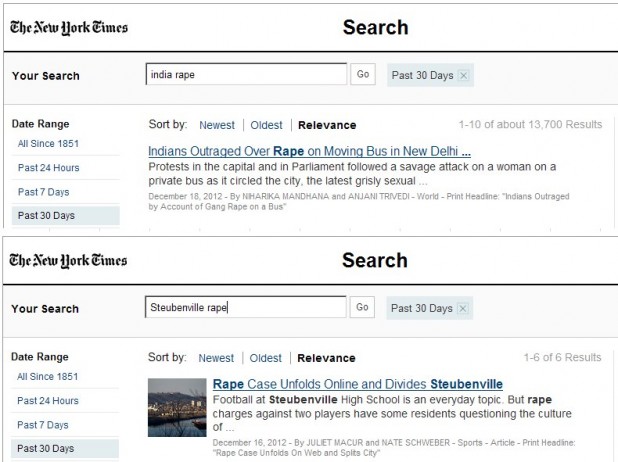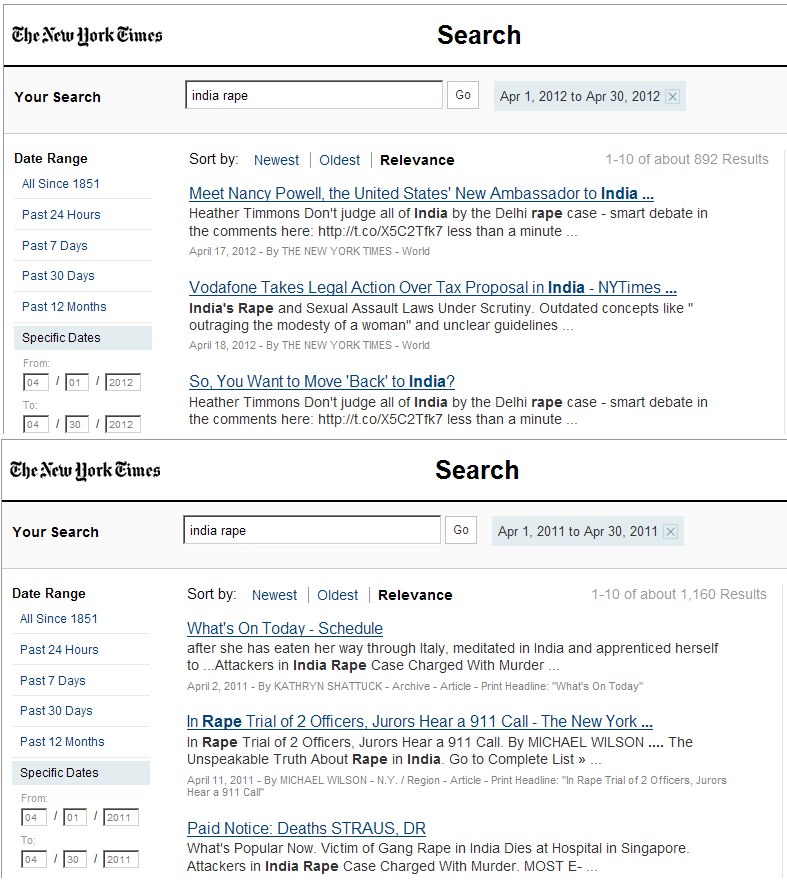GENDER-SEXUALITY » TRUTH ADDICT
Their Rape and Ours at the NYT
January 9, 2013 · 6 Comments
Source: NYTX
Above: Screenshot of results from NYT engine search between “India rape” and “Steubenville rape.” A careful observer will notice that the head article for the two results also display an interesting contrast: For the case in India the emphasis is on how the rapes have “outraged” the community, while in Ohio the incidences “divides.”
By Michael McGehee:
One of the more revealing aspects to any propaganda system is the differentiation between us and them. When a media system, especially a large one like The New York Times, who has an international reach, covers stories or topics at exceedingly disproportionate levels it says a lot about power dynamics. Armed with this investigative tool one can discern between whom and what the media outlets find to be worthy and unworthy of attention.
A recent case in point is the topic of rape and sexual violence.
There is an ongoing media firestorm about the rape and sexual violence in India centering around a couple brutal and disturbing incidences, and this attention is greatly needed and welcomed. But what about our rape and sexual violence?
When High School football players form a “rape crew” in Steubenville, Ohio, and drug and rape young female classmates, and when law enforcement officials and school administration personnel get caught dragging their feet on punishing the perpetrators, as they were by the hacktivist group Anonymous (along with a video they leaked of young boys laughing at the rape of the “dead” girl), one would think this a very worthy news story—especially in light of sexual violence statistics in the United States. In fact, one would think media coverage would exceed that of incidences in foreign countries.
But compared to the recent cases in India, our own New York Times coverage has provided up to twenty-two hundred times as much attention to their problems over our own.
Sadly, this is not shocking. Time and time again the U.S. media has been found to show enormous disparity in coverage of stories and events as they relate to systems of political and economic power (so it’s not at all surprising that the same disparity shows in coverage of gender relations).
In the 1980s two American professors (Edward Herman and Noam Chomsky) even came out with a “propaganda model” that explained how this happens. What the two argue is that coverage is shaped by certain factors that filter out and differentiate between “worthy” and “unworthy” so that by the time a story is published a trend is already set. Ultimately they narrowed it down to five “filters”: ownership, advertisements, sources, flak, and ideology. Since all the major media outlets are for-profit businesses (who have owners) that rely on ad revenue, and whose journalists cannot be everywhere at all times to investigate issues, and therefore often rely on press releases from think-tanks, corporations and governments, and because challenges to dominant ideologies can produce considerable flak, especially by lobby groups backed with money and political connections, Herman and Chomsky presented a persuasive argument that these filters play the dominant part in the final product of the “news” we consume.
If you were to visit the NYT website and type in (without the quotations) “India rape” in their search engine and set the parameters for the last thirty days you will yield “about 13,700″ results. With this staggering figure you can compare it to the results you get when you then type in “Steubenville rape”: a whopping six.
While some of the 13,700 may include pieces within the last thirty days about “rape” in “India” other than the specific incidences at hand there is a way one could reasonably sort that out without the exhaustive browse through all the thousands of articles: check the coverage of previous months for a surge of coverage. If you were to set the date range for a random thirty day period such as April 1 through April 30 of 2012 you get 892. And if you used the same date range, but for 2011, you get 1,160. Assuming a margin of error of about 1,000 pieces that may not be about the ongoing incidences, we are still looking at a ratio of more than 12,000 to 6, or 2,000 to 1. (*A note below compares this query to others as well.)
Screenshot of search for “India rape” in date ranges April 1 through April 30 of the years 2011 and 2012. The results indicate current months results of 13,700 largely reflect the specific incidences that provoked a public outcry in India.
Just over a year ago the “paper of record” noted that “An exhaustive government survey of rape and domestic violence released on Wednesday affirmed that sexual violence against women remains endemic in the United States and in some instances may be far more common than previously thought.”
As far as I can tell the above article was the only one published on the study, leaving the issue dropped, even though the problem persists. The Centers for Disease Control and Prevention note on their “Sexual Violence; Facts at a Glance” for 2012 that 42% of women raped were under the age of 18, and that “Among female rape victims, perpetrators were reported to be intimate partners (51.1%), family members (12.5%), acquaintances (40.8%) and strangers (13.8%).”
With an “endemic” problem of sexual violence of our own it is hard to understand why Times coverage of the two incidences in India (a foreign country and culture) can receive sustained attention, including editorials of Indian victims, to such disparities as 99.5% of the overall coverage between the two Indian incidences and the one American incident (totaling close to 14,000), outside of the possible social ramifications for addressing our own cultural practices as they relate to gender relationships and how our young men are raised to view sex and women. One of the filters of Chomsky’s and Herman’s “propaganda model” that might explain it is that of flak. It says something about how entrenched patriarchy and such atavistic views of gender are in our society when an elected official can feel comfortable in public saying, “If it’s a legitimate rape, the female body has ways to try to shut the whole thing down,” as Republican Congressman Todd Akin did last year (and, yes, I know he lost his seat for it, and that certainly speaks well of the voters who voted him out, but he still garnered almost 40% of the popular vote).
Question: Are Times editors more comfortable providing sustained coverage of a pressing issue in India (which will have virtually no effect) that is also pressing here because of the negative feedback they expect to receive from domestic conservative and religious groups? If not, then what gives?
—
*Note: Upon reading my article comparison of 13,700 to six, interested readers may want to know what other queries of the Times’ database yield on this topic. For example, comparing results for the queries ”India rape” with “U.S. rape” (without quotes and over 30 days) the Times’ search engine generates comparable results: 13,700 to 13,000 respectively. As the Times’ search instructions explain, searching for “college education” without quotes finds all articles containing the words “college” and “education”. But as soon as you add quotation marks the query will find all articles where the words ”college” is followed directly by “education.”
Taking the above into account, when you run a search for “India rape” (using quotation marks and over 30 days) the search yields 917 results. When you compare this with the query “U.S. rape” (also using quotation marks and over 30 days) the search yields zero results! That is interesting — apparently those words don’t appear back-to-back in the Times’ database.
Now, when you search for ”Steubenville rape” (not using quotation marks and over 30 days) the query yields — as pointed out in the body of my article above - only six results, and without quotation marks it yields only one result.














Nicholas Kristof of the Times puts the two stories in context, & he brings in another important element: the House’s refusal to reauthorize the Violence Against Women Act. (Kristof doesn’t say so, but House Republicans reportedly object to the fact that the bill now specifically protects Amerindian women because, something, something “tribal councils.” First time I realized conservatives cared about the autonomy of tribal councils.) Abby Rogers of Business Insider made the connection between the House & Steubenville in this January 8 post prior to Kristof’s raising it. They’re both right, IMHO.
I would not fault the Times for carrying fewer stories about Steubenville than about the gang rape(s) in India. The stories are, after all, less about the rapes themselves than about public reaction to them. Public reaction to the Steubenville rape & assault has been — according to the Times article — “divided”; Indian citizens & public officials have expressed such outrage that cultural and legal changes appear to be in the offing.
Indeed, I thought the Times reporters did a good job of reflecting the responses in Steubenville to the hours-long assault. The school did nothing to punish football players who were clearly closely involved, if not directly involved, in the rape itself, & the football coach appeared as a character witness for one of the accused rapists. Meanwhile, the victim is being ostracized, according to the Times report.
I have a completely different take on the Times reporting here. Although the reporters act as “neutral” observers, what their reports show is that India is taking these rapes seriously, and the U.S. is largely ignoring a gang rape while locals try to “move on” & enjoy their football games.
I don’t think the Times reporting is by any means making “us” look better than “them.” Neither does Kristof.
Marie
uts the two stories in context, & he brings in another important element: the House’s refusal to reauthorize the Violence Against Women Act. (Kristof doesn’t say so, but House Republicans reportedly object to the fact that the bill now specifically protects Amerindian women because, something, something “tribal councils.” First time I realized conservatives cared about the autonomy of tribal councils.) Abby Rogers of Business Insider made the connection between the House & Steubenville in this January 8 post prior to Kristof’s raising it. They’re both right, IMHO.
I would not fault the Times for carrying fewer stories about Steubenville than about the gang rape(s) in India. The stories are, after all, less about the rapes themselves than about public reaction to them. Public reaction to the Steubenville rape & assault has been — according to the Times article — “divided”; Indian citizens & public officials have expressed such outrage that cultural and legal changes appear to be in the offing.
Indeed, I thought the Times reporters did a good job of reflecting the responses in Steubenville to the hours-long assault. The school did nothing to punish football players who were clearly closely involved, if not directly involved, in the rape itself, & the football coach appeared as a character witness for one of the accused rapists. Meanwhile, the victim is being ostracized, according to the Times report.
I have a completely different take on the Times reporting here. Although the reporters act as “neutral” observers, what their reports show is that India is taking these rapes seriously, and the U.S. is largely ignoring a gang rape while locals try to “move on” & enjoy their football games.
I don’t think the Times reporting is by any means making “us” look better than “them.” Neither does Kristof.
Marie
The comment above is missing the first part of the first paragraph: my comment begins,
Nicholas Kristof of the Times puts the two stories in context, & he brings in another important element: the House’s refusal to reauthorize the Violence Against Women Act. (Kristof doesn’t say so, but House Republicans reportedly object to the fact that the bill now specifically protects Amerindian women because, something, something “tribal councils.” First time I realized conservatives cared about the autonomy of tribal councils.) Abby Rogers of Business Insider made the connection between the House & Steubenville in this January 8 post prior to Kristof’s raising it. They’re both right, IMHO.
etc., etc.
In what little coverage the NYT provided on Steubenville it was good, agreed. But the volume in which they provided is, I think, revealing. The issue in the US is hardly new, and as the NYT has noted briefly: a big problem.
I just don’t buy that the NYT is simply responding to “public reaction,” so that 2,000 to 1 they talk about Delhi and not Steubenville. One could say that the articles are about “public reaction” but it could be easily turned around and pointed out that “public reaction” might have been considerably different had the media provided indepth and sustained coverage. The pattern wasn’t just at the NYT, but WP, WSJ, USA Today, etc.
The pattern of selectivity comes up quite a bit. There is Yousafzai Malala as another recent example. Huge media outcry about her. Or Neda Agha-Soltan, the Iranian woman killed a few years back. But we can easily find other examples where there was no outcry, like Isis Obed Murillo, the Honduran woman killed during the coup.
2,000 to 1 is just too much to be a coincidence, and not indicative of something more systemic.
First, the New York Times has been credited as being the major news outlet which brought the Steubenville story to national attention. (Also here
and elsewhere.)
Second, the Steubenville assaults took place last August 11; the first gang rape in India (that is the subject of the protests) was in mid-December. So is it really so surprising that a story that unfolded during the 30-day period you flagged — and which has been carried in media outlets around the world — would get a lot more attention than one based on an event that took place months before the period you reviewed?
As you may know, I’m all in favor of calling out the Times for shoddy reporting, biased reporting, ridiculous commentary or just plain ignoring important stories (e.g., the Bradley Manning case). But when “the paper of record” is the outlet that picks up a story off the Internet & puts it in dead-tree black-and-white, and that story generates more stories from other major media outlets (not all of them exactly helpful to women’s rights), I think readers should applaud the paper, not criticize it.
There are plenty of places the Times falls down on the job; reporting the Steubenville assaults doesn’t seem to me to be one of them.
Marie
Even if you go back to all of August and September you still dont see the level of coverage provided to India. And anyway, what brought the story back in the news was the Anonymous leaks, which I would think would elevate the story since a) the hacktivist group provided proof of mishandling the situation by school and law officials; and b) the NYT had reported in a singular article on the severity of the problem of sexual violence in the US. We are still talking of a massive disparity in coverage, and I think that is fair grounds to criticize the NYT.
To illustrate the disparity: If all of the individual nyt articles and blogs between the two were broken up in a day we would see just over half a minute given to Steubenville while the rest of the day would be non-stop coverage of the gang rapes in Delhi.
That’s a bit much.